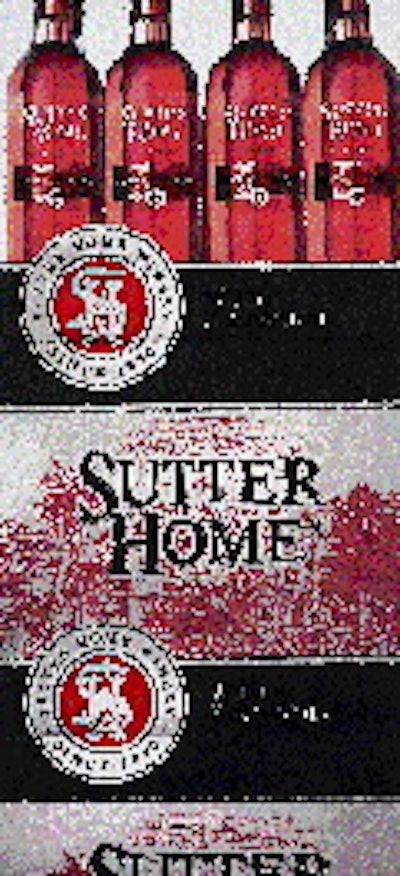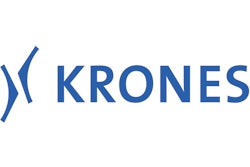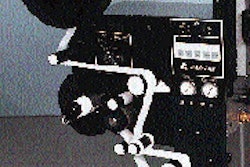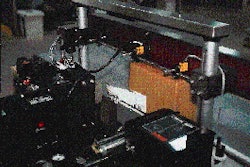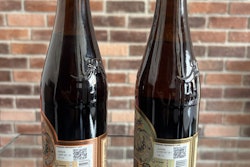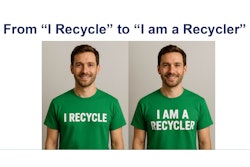Always an innovator when it comes to packaging, Sutter Home Winery of St. Helena, CA, has done it again. Among its newly designed bottles for its "core line" of varietals is a 750-mL White Zinfandel bottle that represents one of the first narrow-neck press-and-blow bottles in the world for traditional long cork applications. Because press-and-blow technology permits better in-mold control of molten glass than blow-and-blow, less glass can be used. Thus, the 15-oz flint bottle now used for White Zinfandel is 2.5 to 3 oz lighter than its emerald green predecessor. The bottle comes from Owens-Brockway (Toledo, OH). The key to press-and-blow glass-making technology, and the reason it allowed Sutter Home to lightweight its bottle, is that it produces bottles with greater uniformity in wall thickness compared to conventional blow-and-blow bottles. That translates into greater strength, which in turn means less material and reduced costs. Press-and-blow has been used for wide-mouth glass containers since the '30s. But only in the last 10 years or so have commercial glass manufacturers perfected this technology to produce narrow-neck beer and spirits packages. And until Sutter Home's White Zinfandel bottle emerged from its mold at Owens-Brockway's Oakland plant last year, no one had been as successful at using press-and-blow to make a narrow-neck bottle for a corkage application. At least, not in Sutter Home-type quantities. To understand this sequence of technological advancements, it helps to review the fundamental differences between the two glass manufacturing methods. With blow-and-blow, once the "gob" of molten glass is in the parison mold, compressed air is blown into the mold to force the glass down into the finish area; this is called the "settle blow." At this point the bottle finish is complete. Then air is blown up through the finish in what's called the "counterblow" to expand the glass upward in a long, narrow preform or parison. The parison is removed from the parison mold and held by the finish as it is rotated right-side-up and placed in the blow mold. Air forces the glass to conform to the shape of the mold. All that remains is annealing, coating and cooling and the bottle is done. No counter blow With press-and-blow, gob delivery and settle blow are essentially the same. But there is no counter blow. Instead, the material is pressed into the parison mold with a metal plunger. It's because the parison is formed by means of this mechanical action instead of by blown air that distribution of material is more uniform. Pressing the parison into the parison mold with a plunger is fairly simple with wide-mouth jars because there's no long neck to contend with. So wide-mouth containers were the first to be produced with press-and-blow technology. Only when glass manufacturers developed new generations of plungers, some made of tungsten or other advanced metals that could withstand intense heat and wouldn't stick to the molten glass, did narrow-neck press-and-blow become commercially viable. Even as it did, wine bottles were left out, primarily because of a simple fact of bottle-neck geometry. That is, a wine bottle's neck must be smaller in diameter at the finish and flared out near the shoulder so that after a cork is pushed in and has had a chance to expand slightly, it can only be pulled from the tapered finish with considerable effort. Owens-Brockway's key accomplishment for Sutter Home's bottle was developing a plunger that would press the flared-out shape required in a wine bottle's neck yet still be retractable through a finish area smaller in diameter than the flanged area it had just created. More specific details about this innovative plunger are not available from the glass manufacturer. In addition to being lighter due to its improved material distribution, a bottle made via press-and-blow has fewer defects, distortions and waves. This uniformity figures prominently in Sutter Home's transparent wines, because even when the bottle is held to the light, its clarity is undisturbed by imperfections. As Owens-Brockway's Roland Pimm puts it, "It's almost like looking at a clear plastic cylinder." Thus far, the only varietals Sutter Home has packaged in narrow-neck press-and-blow bottles are the two that come in the flint claret-style bottle: White Zinfandel and Sauvignon Blanc. According to Owens-Brockway, it's only a matter of time before the tinted bottles used for Cabernet, Zinfandel, Merlot and Chardonnay are switched to narrow-neck press-and-blow as well. At this relatively early stage in its development, the bottle is not positioned by Owens-Brockway as a cost saver, even though it's about 20% lighter than its blow-and-blow counterpart. For now, at least, Owens positions the bottle as being of a higher quality because sidewall uniformity is greater. In time, however, weight reduction should become more critical, not only because a winery is buying less glass but also because it's sending less tonnage throughout its distribution system. Four labels As impressive as this bottle's development might be, just as striking is what Sutter Home has done with label graphics across its entire line of varietals in both 750-mL and 1.5-L sizes. In place of front and back paper labels applied with cold glue are these four labels: * From Spear (Mason, OH), a front logo label and back label of 2-mil clear biaxially oriented polypropylene is screen-printed on a flat-bed press. The back label is printed in black and white so that a bar code can be incorporated; the front label is white ink only, but it also has a gold drop shadow hot-stamped in the same pass. Both are pressure-sensitive. * From fp Label (Napa, CA), a front varietal label of metallized 50# paper is printed offset in four colors. In a second pass this label is hot-stamped in gold, and in a third pass an ultraviolet-cured coating provides scuff resistance and gloss. The label is cold glue-applied. * Also from fp Label, a neck label of 52# metallized paper is printed offset in four colors and an aqueous coating all in one pass. Also applied with cold glue, this label is used only on the 750-mL bottles, not the 1.5-L. Packaging revolution In an industry where packaging is undergoing a not-so-quiet revolution, Sutter Home's redesign, by Landor Assoc. (San Francisco, CA), has everybody talking. That suits marketing vice president Mike Yeager just fine. "The supermarket wine section is for the most part a bunch of bottles with paper labels all lined up next to each other," says Yeager. "You see very little differentiation. We felt there was an opportunity not only to have a more distinctive look but also to project a more premium image than our previous labels gave us while still maintaining some of that label's equity." The premium image is further enhanced by the push-up or "punted" bottom on the redesigned bottle. Two other packaging components on the 750-mL bottle deserve mention: cork and capsule. Previously unprinted, the cork now used is decorated with a stylish Sutter Home seal woodcut motif. The capsule is clear polyvinyl chloride so that the woodcut shows through. Extruded by Sofacap in Toulouse, France, it's sold in the U.S. by fp Packaging (Napa, CA). The capsule is applied and heat shrunk by the same equipment Sutter Home used for the opaque PVC capsule that has been replaced. A special feature of the new capsule makes opening easier. "It's perforated on top so that if you put a cork screw through the top and then pull, the capsule top breaks free," says Yeager. "You don't have to cut the capsule off." New labelers necessary Though equipment for capsule application remained the same, as did just about everything else in the bottling and packaging lines at Sutter Home, labeling equipment is new. Three Autocol Combi labelers from Krones (Franklin, WI) were installed last March. Two are dedicated to lines filling 750-mL bottles. Despite application of two pressure-sensitive film labels (front logo label and back label) and two cold-glue-applied paper labels (neck label and front varietal label), the two labelers handling 750-mL bottles run as fast as 375 bottles/min. A third labeler, for 1.5-L bottles, applies only three labels since this larger bottle gets no neck label. "We didn't have a lot of options on labelers when we needed to apply four labels at these speeds," says vice president of production Jim Huntsinger. The two paper labels are applied first in a single station, then the p-s film labels are each applied in separate stations. The 30-platform rotary machine is one of the first ever by Krones that combines pressure-sensitive and cold glue labels. It employs an LRD2100 capacitive sensor from Lion Precision (St. Paul, MN) that is uniquely capable of sensing the leading edge of the virtually invisible clear film label. "It's a noncontact, nonoptical sensor that looks at the dielectric properties of the material beneath it," says Lion's Nick Marchuk. "Those properties change when material thickness changes. So when label and web together are passing through the sensing field, that's one reading, but web only is another." This is how the sensor always knows where the label is. When the label is detected, the sensor sends a signal to the labeler so that the label can be applied accurately. Lion claims the LRD2100 can hold repeatability to within 1/128th of an inch. Productivity drop-off minimal "One thing we counted on experiencing once we made the change in labels was a drop in productivity," says Huntsinger. "Any time you go from two to four labels, when you actually count how many bottles you've put into the barn at the end of the day, it's going to be slightly less than when you were doing only two labels. But the dropoff was not as great as I anticipated it would be, and it's disappearing as we continue getting up the learning curve." The other key issue for Sutter Home was the obvious increase in label costs when two paper labels were replaced by two metallized paper labels and two film labels. Though he chooses not to be specific about what the upcharge is, Huntsinger says, "We anticipated it, we have it managed, and we think it's worth doing." In addition to being the talk of the wine industry, Sutter Home's new look won the Glass Packaging Institute's 1995 Clear Choice Award in the "Mature Product" category. The importance of the package is not lost on marketing vice president Yeager. "Because the wine industry doesn't do a lot of advertising, packaging is the best way to convey a brand's positioning," he points out. "With this new look we feel we retain some of the traditional elements you'd expect to find in wine packaging, yet it's still innovative enough to appeal to a slightly younger audience that we feel should be tapped." Even the corrugated shippers that bring the new bottle to market have been redesigned to create an interlocking graphic effect when stacked. But the real story is the redesigned bottle. According to research by Landor, purchase interest among consumers jumped an average of 45% in response to it. No wonder a recent Sutter Home message to the supermarket trade ends with the prediction that, thanks to the redesign, "our wine, and your business, will be looking better than ever."
